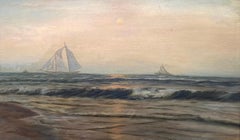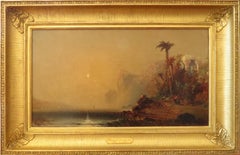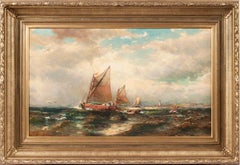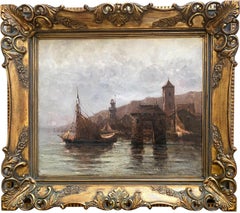Franklin D. Briscoe Art
American, 1844-1903
History and marine painter Franklin Dullin Briscoe was born in Baltimore, Maryland, in 1844 and studied in Philadelphia with Edward Moran in 1860. Like many of his contemporaries, he then went abroad to further his artistic education, visiting London and Paris before returning home and establishing his studio in Philadelphia. Briscoe made several more ocean voyages during his career, experiences that inspired the dramatic seascapes and shipping scenes for which he is today best known. The weather was an especially important factor in his work, whether capturing fishermen returning after a long day’s work under calm, luminist skies to his paintings of storm-tossed ships and sailors at the mercy of the wind and waves. (Biography provided by Helicline Fine Art)
to
3
3
1
1
“Sailboats off the Coast”
By Franklin D. Briscoe
Located in Southampton, NY
Original oil on academy board by the well known American marine artist, Franklin Dullen Briscoe. Signed lower right. (Under gold liner) Circa 1885. C...
Category
1880s Academic Franklin D. Briscoe Art
Materials
Oil, Fiberboard
"Greek Ruins"
By Franklin D. Briscoe
Located in Lambertville, NJ
Signed Lower Right
Known for his marine, history, and portrait paintings, Franklin Briscoe was born in Baltimore, Maryland and at age four moved with his family to Philadelphia where he later became a student of Edward Moran and where eventually he settled his studio.
Briscoe made extended ocean voyages, including trips to Europe where he saw much painting in galleries, and from these adventures and observations developed his landmark paintings of the ocean and ships in all kinds of weather conditions.
In 1885, he painted an historical mural that was in ten panels, a total of 230 feet long, and 13 feet tall--"The Battle of Gettysburg...
Category
19th Century Hudson River School Franklin D. Briscoe Art
Materials
Canvas, Oil
"Palms at Sundown"
By Franklin D. Briscoe
Located in Lambertville, NJ
Signed LR
Known for his marine, history, and portrait paintings, Franklin Briscoe was born in Baltimore, Maryland and at age four moved with his family to Philadelphia where he later became a student of Edward Moran and where eventually he settled his studio.
Briscoe made extended ocean voyages, including trips to Europe where he saw much painting in galleries, and from these adventures and observations developed his landmark paintings of the ocean and ships in all kinds of weather conditions.
In 1885, he painted an historical mural that was in ten panels, a total of 230 feet long, and 13 feet tall--"The Battle of Gettysburg...
Category
19th Century Franklin D. Briscoe Art
Materials
Canvas, Oil
Related Items
Seascape by George Herbert McCord (American, 1848-1909)
By George Herbert McCord
Located in New York, NY
"Seascape," by Hudson River School artist George Herbert McCord (1848-1909) is oil on canvas and measures 18.07 x 30.13 inches. The work which comes from a private collection in Birmingham, Alabama is signed “G.H. McCord A.N.A.” at the lower left. The work is framed in a beautiful, period appropriate frame, and ready to hang.
A member of the second generation of Hudson River School painters, George Herbert McCord is known for his atmospheric landscape and marine paintings which capture a variety of locales and are executed in a variety of media—including oil, pastel, and watercolor. McCord was born in 1848 in New York City, where he lived and worked his entire life. After
1883, he kept an additional studio in Morristown, NJ. McCord traveled throughout North America, painting in the Berkshire, Adirondack and Laurentian mountain ranges, the Hudson River Valley, the Coast of New England, the Upper Mississippi, and Florida, which had become popular among Eastern vacationers. He was among a select group of artists commissioned by the Santa Fe Railroad to paint the Grand Canyon, and also participated in a special painting excursion to the Erie Canal. His travels in Europe were equally expansive, taking him to England, Scotland (having been commissioned by Andrew Carnegie to paint the scenery around his castle there), France, the Netherlands, and Italy.
McCord was well-educated, having attended Claverack College amidst the Catskills in Claverack, NY, which provided instruction in classical, French, German, English, music, painting, military, commercial, telegraphic and agricultural studies. He also studied with the accomplished painter and inventor of Morse code, Samuel F.B. Morse, and with the Scottishborn
landscape painter, James Fairman.
McCord was active in numerous art clubs and institutions in New York, including the National Academy of Design, which elected him an Associate member in 1880, the American Watercolor Society, the Brooklyn Art...
Category
19th Century Hudson River School Franklin D. Briscoe Art
Materials
Oil, Canvas
Southern City by the sea atmospheric large blue green seascape harbour painting
Located in Norwich, GB
A very atmospheric and idyllic view of a Southern fishing port, painted most likely in Italy or France. Resolutely post-impressionist, the landscape is imbued with the light of the M...
Category
Early 20th Century Post-Impressionist Franklin D. Briscoe Art
Materials
Canvas, Oil, Fiberboard
H 29.14 in W 33.86 in D 2.76 in
small oil landscape "Village 3"
Located in Sempach, LU
small oil landscape on cardboard “Village 3”, drawn by Natalya Shiporina, signed to the verso. The painting is part of a series of three paintings...
Category
2010s Academic Franklin D. Briscoe Art
Materials
Oil, Cardboard
Early oil depicting the Great Fire of London
Located in London, GB
The Great Fire of London in September 1666 was one of the greatest disasters in the city’s history. The City, with its wooden houses crowded together in narrow streets, was a natural fire risk, and predictions that London would burn down became a shocking reality. The fire began in a bakery in Pudding Lane, an area near the Thames teeming with warehouses and shops full of flammable materials, such as timber, oil, coal, pitch and turpentine. Inevitably the fire spread rapidly from this area into the City. Our painting depicts the impact of the fire on those who were caught in it and creates a very dramatic impression of what the fire was like. Closer inspection reveals a scene of chaos and panic with people running out of the gates. It shows Cripplegate in the north of the City, with St Giles without Cripplegate to its left, in flames (on the site of the present day Barbican). The painting probably represents the fire on the night of Tuesday 4 September, when four-fifths of the City was burning at once, including St Paul's Cathedral. Old St Paul’s can be seen to the right of the canvas, the medieval church with its thick stone walls, was considered a place of safety, but the building was covered in wooden scaffolding as it was in the midst of being restored by the then little known architect, Christopher Wren and caught fire. Our painting seems to depict a specific moment on the Tuesday night when the lead on St Paul’s caught fire and, as the diarist John Evelyn described: ‘the stones of Paul’s flew like grenades, the melting lead running down the streets in a stream and the very pavements glowing with the firey redness, so as no horse, nor man, was able to tread on them.’
Although the loss of life was minimal, some accounts record only sixteen perished, the magnitude of the property loss was shocking – some four hundred and thirty acres, about eighty per cent of the City proper was destroyed, including over thirteen thousand houses, eighty-nine churches, and fifty-two Guild Halls. Thousands were homeless and financially ruined. The Great Fire, and the subsequent fire of 1676, which destroyed over six hundred houses south of the Thames, changed the appearance of London forever. The one constructive outcome of the Great Fire was that the plague, which had devastated the population of London since 1665, diminished greatly, due to the mass death of the plague-carrying rats in the blaze.
The fire was widely reported in eyewitness accounts, newspapers, letters and diaries. Samuel Pepys recorded climbing the steeple of Barking Church from which he viewed the destroyed City: ‘the saddest sight of desolation that I ever saw.’ There was an official enquiry into the causes of the fire, petitions to the King and Lord Mayor to rebuild, new legislation and building Acts. Naturally, the fire became a dramatic and extremely popular subject for painters and engravers. A group of works relatively closely related to the present picture have been traditionally ascribed to Jan Griffier...
Category
17th Century Old Masters Franklin D. Briscoe Art
Materials
Oil, Canvas
Full Sail at Twilight by Hudson River School Artist J.B. Bristol (1826–1909)
By John Bunyan Bristol
Located in New York, NY
Painted by Hudson River School artist J.B. Bristol (1826–1909), "Full Sail at Twilight" is oil on canvas, measures 12 x 18 1/8 inches, and is signed at the lower right. The work is f...
Category
19th Century Hudson River School Franklin D. Briscoe Art
Materials
Oil, Canvas
"Sundown" Western Shoot Out, Mid Century Figurative Action Scene
Located in Soquel, CA
A dramatic mid-century western figurative action scene depicting a shootout in an old western town by Randy Steffen (American, 1917-1977), 1947. Several ...
Category
1940s American Impressionist Franklin D. Briscoe Art
Materials
Oil, Fiberboard
H 28.25 in W 22.25 in D 1.25 in
A Day in November, 1863 by James MacDougal Hart (American: 1828–1901)
By James McDougal Hart
Located in New York, NY
A prominent 19th century landscapist, Hudson River School painter James McDougal Hart's (1828-1901) A Day in November, 1863 is oil on canvas and measures 10.5 x 18 inches. The painti...
Category
19th Century Hudson River School Franklin D. Briscoe Art
Materials
Canvas, Oil
Anglers on an Adirondack Lake by Ernest Parton (American, 1845-1933)
By Ernest Parton
Located in New York, NY
Hudson River School artist Ernest Parton's (1845-1933) "Anglers on an Adirondack Lake" is oil on canvas, measures 10 x 20 inches, and is signed and dated 1871 at the lower left. The ...
Category
19th Century Hudson River School Franklin D. Briscoe Art
Materials
Oil, Canvas
Mink Hollow Brook by Hudson River Artist Jervis McEntee (American, 1828-1891)
By Jervis McEntee
Located in New York, NY
"Mink Hollow Brook," by Hudson River School artist Jervis McEntee (1828-1891) depicts the lush foliage, and rocky terrain surrounding a Catskill brook. This 19th century oil paintin...
Category
19th Century Hudson River School Franklin D. Briscoe Art
Materials
Oil, Canvas
Shawangunk Mountains by Lemuel Maynard Wiles (American, 1826-1905)
Located in New York, NY
Shawangunk Mountains [View from top of Granit Road Looking Southeast] by Hudson River School artist Lemuel Maynard Wiles (1826-1905) is oil on can...
Category
19th Century Hudson River School Franklin D. Briscoe Art
Materials
Board, Oil, Canvas
Camel's Hump, Vermont, 1877 by Laura Woodward (American, 1834-1926)
By Laura Woodward
Located in New York, NY
Painted by Hudson River School artist Laura Woodward (1834-1926), "Camel's Hump, Vermont" 1877 is oil on canvas and measures 14 x 24 inches. It is signe...
Category
19th Century Hudson River School Franklin D. Briscoe Art
Materials
Oil, Canvas
Hudson River Landscape, 1865 by Johann Hermann Carmiencke (American, 1810-1867)
By Johann Hermann Carmiencke
Located in New York, NY
Painted by Hudson River School artist Johann Hermann Carmiencke, "Hudson River Landscape" 1865 is oil on canvas, measures 12 x 18 inches, and is signed and dated 1865 at the lower ri...
Category
19th Century Hudson River School Franklin D. Briscoe Art
Materials
Canvas, Oil
Franklin D. Briscoe art for sale on 1stDibs.
Find a wide variety of authentic Franklin D. Briscoe art available for sale on 1stDibs. You can also browse by medium to find art by Franklin D. Briscoe in oil paint, paint, canvas and more. Not every interior allows for large Franklin D. Briscoe art, so small editions measuring 19 inches across are available. Customers who are interested in this artist might also find the work of Ferdinand Victor Leon Roybet , Edmund Darch Lewis, and William Rickarby Miller. Franklin D. Briscoe art prices can differ depending upon medium, time period and other attributes. On 1stDibs, the price for these items starts at $2,400 and tops out at $43,000, while the average work can sell for $43,000.




